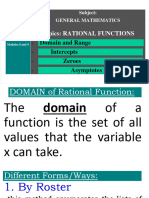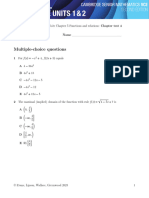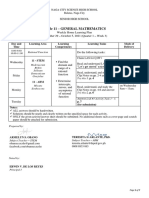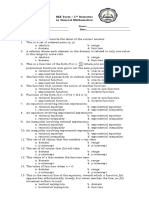– Radical Functions / Square Root of a Function Answers are on the back page
1. For a function defined by 𝑦 = −2√𝑥 + 3 + 5,
www.rtdmath.com
(a) State the domain and range, and explain how they relate to
the parameters of the equation in the form 𝑎√𝑥 − ℎ + 𝑘
(b) Algebraically determine any 𝑥, 𝑦 intercepts
Exact values
2. A radical function 𝑟(𝑥) has a domain of 𝑥 ≥ −2, a range 𝑦 ≥ −3, and has an 𝑥-intercept
NR 𝑥 = −1. For an equation in the form 𝑦 = 𝑎√𝑥 − ℎ + 𝑘, the value of 𝑎 is ______.
3. A radical function has an equation 𝑦 = −√𝑏𝑥 + 6. The domain of the function is:
6 −6
MC A. 𝑥 ≥ B. 𝑥 ≥ 6 C. 𝑥 ≥ D. 𝑥 ≥ −6
𝑏 𝑏
4. For each given graph of 𝑦 = 𝑓(𝑥), sketch the graph of 𝑦 = √𝑓(𝑥), and state its domain, range, and any
invariant points.
(a) Domain of 𝑦 = √𝑓(𝑥): (b) Domain of 𝑦 = √𝑓(𝑥):
Range of 𝑦 = √𝑓(𝑥): Range of 𝑦 = √𝑓(𝑥):
Equation of 𝑦 = √𝑓(𝑥) Equation of 𝑦 = √𝑓(𝑥)
In form 𝑦 = √(𝑥 − 𝑚)(𝑥 − 𝑛)
www.rtdmath.com
(c) For both functions above (from parts a and b), determine the coordinates of any invariant points. Exact values where
applicable.
� www.rtdmath.com
5. Sketch the graph of = √𝑓(𝑥) , and state its domain, range, and
coordinates of any invariant points. Exact values where applicable.
𝒇(𝒙) = −𝒙𝟐 + 𝟏𝟔
Use the following information to answer the following three questions
The graphs of two functions, 𝒚 = 𝒇(𝒙) and
𝒚 = 𝒈(𝒙) are shown. 𝒈(𝒙)
𝒇(𝒙)
The graph of 𝑓(𝑥) is a line, while the graph of
𝑔(𝑥) is a parabola with its vertex on the origin.
A function 𝒉(𝒙) is defined ℎ(𝑥) = 𝑔(𝑥) + 1
A function 𝒑(𝒙) is defined 𝑝(𝑥) = 𝑔(𝑥) + 4
6.
NR
www.rtdmath.com
The most likely domain for 𝑦 = √𝑓(𝑥) is _______ and for 𝑦 = √𝑔(𝑥) is ______.
first digit second digit
Use the following codes to complete the sentence above
Possible domains 1 𝑥∈ℝ 2 𝑥 ≥ −1 3 𝑥≥3 4 𝑥 ≠ −1 5 𝑥≥0 6 𝑥≠3
7. The most likely range for 𝑦 = √𝑓(𝑥) is _______ and for 𝑦 = √𝒑(𝒙) is ______.
first digit second digit
NR
Use the following codes to complete the sentence above
Possible ranges 1 𝑦∈ℝ 2 𝑦≥0 3 𝑦≥1 4 𝑦≥2 5 𝑦≥3 6 𝑦≥4
8. The number of invariant points on 𝑦 = √𝑓(𝑥) is _______, for 𝑦 = √𝑔(𝑥) is ______, and
first digit second digit
NR for 𝑦 = √ℎ(𝑥) is _____.
third digit
– Rational Functions
2𝑥 − 5
9. Given a function 𝑦 = , determine (without the use of technology):
www.rtdmath.com
𝑥+1
(a) The equation of any (b) The equation of any (c) The value of any 𝑥 or 𝑦 intercepts
vertical asymptote horizontal asymptote
�10. Determine (without the use of technology) any vertical or horizontal asymptote(s) for each given function:
(a) 𝑓(𝑥) =
www.rtdmath.com
𝑥2
5
− 3𝑥 − 4
(b) 𝑓(𝑥) =
2𝑥 2
𝑥 2 − 3𝑥
(c) 𝑓(𝑥) =
3
𝑥+1
−2
3(𝑥 + 2)(𝑥 − 𝑎)
11. A function 𝑔(𝑥) = , where 𝑎 ∈ ℕ, has a domain of {𝑥 ∈ ℝ | 𝑥 ≠ 3} and a graph with no
(𝑥 − 3)
vertical asymptotes. Determine the 𝑥-intercept and coordinates of the point of discontinuity.
𝑥+3
12. Given a function 𝑦 = 𝑥 2 − 𝑥 − 12 , determine (without the use of technology):
(a) The equation of any
vertical asymptote(s)
www.rtdmath.com
(b) The equation of any
horizontal asymptote
(c) The coordinates of any point(s) of
discontinuity
13. The rational function shown has a vertical asymptote at 𝑥 = −1, passes
through the origin, and passes through the point (1, −1). Determine a
possible equation, in the form
𝑓(𝑥) where 𝑓(𝑥) and 𝑔(𝑥) are both linear functions
𝑦=
𝑔(𝑥)
14. The rational function shown has one vertical asymptote, one point of
discontinuity, and passes through the point (−3, 2). Determine a possible
𝑦=
www.rtdmath.com
equation, in the form
𝑎(𝑥 − 𝑏)
2
𝑥 + 𝑐𝑥 − 𝑑
� Use the following information to answer the following three questions
𝑎(𝑥 − 𝑏)(𝑥 − 3)
A function 𝑓(𝑥) is given by 𝑓(𝑥) = , where 𝑎 ≠ 0, 𝑏 ≠ 3 and 𝑏 ∈ Integers
2𝑥 2 − 5𝑥 − 3
15.
MCwww.rtdmath.com The graph of 𝑦 = 𝑓(𝑥) has a vertical asymptote at:
A. 𝑥 = 𝑎 B. 𝑥 = −
1
2
C. 𝑥 = 𝑏 D. 𝑥 = 3
16. The graph of 𝑦 = 𝑓(𝑥) has an 𝑥-intercept at:
1
MC A. 𝑥 = 𝑎 B. 𝑥 = 3 C. 𝑥 = − D. 𝑥 = 𝑏
2
17. The graph of 𝑦 = 𝑓(𝑥) has a horizontal asymptote at:
𝑎 𝑏
MC A. 𝑦 = 𝑎 B. 𝑦 = 0 C. 𝑦 = D. 𝑦 =
2 2
𝑥 2 − 5𝑥 + 𝑏
18.
www.rtdmath.com
A rational function given by 𝑦 = has a point of discontinuity at (3, 1).
𝑥−𝑎
NR
The value of 𝑎 is _____ and the value of 𝑏 is _____.
first digit second digit
19. A rational function given by the graph shown has an equation of the form
NR 𝑎(𝑥 − 1)(𝑥 − 𝑏)
where 𝑎, 𝑏, and 𝑐 are positive integers. The graph has a point of
𝑦=
𝑥 2 − 5𝑥 + 𝑐 discontinuity, an 𝑥-intercept, and vertical asymptote as shown.
The value of 𝑎 is _____, 𝑏 is _____, is _____.
first digit second digit third digit
(𝟓, 𝟒)
(𝟑, 𝟎)
www.rtdmath.com
Answers For full, worked-out solutions (as well as other practice materials) visit www.rtdmath.com)
𝑥 ≥ −3, 𝑦 ≤ 5 𝑦 = −2√3 + 5 𝑥 = 3.25 𝑎=3 C 𝑥 ≥ −2, 𝑦 ≥ 0, 𝑦 = √2𝑥 − 4
𝑥 ≤ −1 or 𝑥 ≥ 3 𝑦 ≥ 0 𝑦 = √(𝑥 + 1)(𝑥 − 3) For (a)… (2, 0) & (5/2, 1) For (b)… (−1, 0), (3, 0), (1 − √5, 1), (1 + √5, 1)
Domain: [−4, 4] Range: [0, 4] INV Pts: (−4, 0), (4, 0), (−√15, 1), (√15, 1) 31 24 231
𝑥 = −1 𝑦=2 𝑥 = 5/2, 𝑦 = −5 𝑥 = −1 and 4, 𝑦 = 0 𝑥 = 0 and 3, 𝑦 = 2 𝑥 = −1, 𝑦 = −2
(3, 15) 𝑥=4 𝑦=0 (−3, −1/7) −2𝑥 2(𝑥 − 1)
𝑦= 𝑦= 2
𝑥+1 𝑥 + 3𝑥 − 4
B D C 36 234 This practice exam is provided by RTD Learning - for use by Alberta students and teachers






































































































